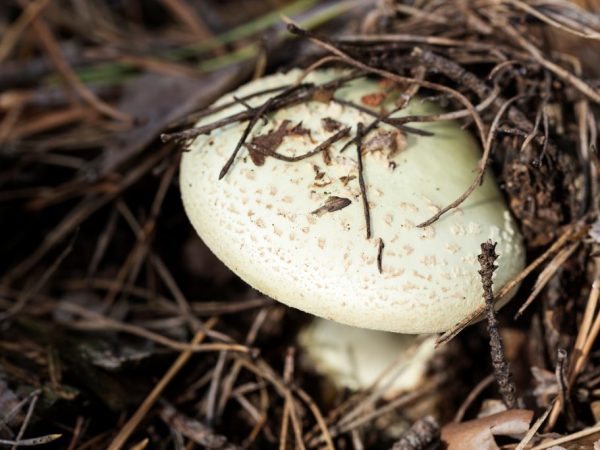Description of yellow-skinned champignon
Peppers (they are champignons) are highly valued for their excellent taste and delicate aroma, so they are not only harvested in the forest, but also grown on an industrial scale. However, there are still lovers of "quiet hunting" who are able to stumble upon the yellow-skinned champignon and put it in their basket. And he is poisonous.

Description of yellow-skinned champignon
Description
Among the people, yellow-skinned champignon has several more synonymous names:
- Red champignon.
- Yellow-skinned peppermint.
From the name it is clear that its characteristic feature is yellowness, hence the complete description of the species. The yellow-skinned champignon is identical to its edible counterpart, only its cap is not just a solid white color, but white with yellowish splashes. The same inclusions are observed at the base of the leg.
Young fruit bodies have round, dense caps, which open as they ripen, becoming almost flat. The diameter of the cap is from 5 to 12 cm.
The leg is hollow inside, slightly thickened at the base. Its color is white, with well-defined yellowish dots at the base. The length is about 6-10 cm, the diameter is up to 2 cm. Young mushrooms have a “skirt” on the stem, which covers the plates. In an adult mushroom, the "skirt" is torn or almost completely absent.
The plates of young fruit bodies are usually pink or white; as the mushroom matures, they acquire a gray-brown hue. The spore powder is dark brown in color.
The flesh is brownish; when pressed, it clearly turns yellow.
Where grows
Yellow-skinned champignon is found everywhere. It grows in Europe, Russia, America, and was even introduced to Australia. Since the yellow-skinned champignon is not a species that is valuable as a food or medicinal crop, most likely the species was accidentally introduced to Australia.
It is often found in deciduous gardens, parks, garden plots - wherever trees and short grass grow.
The harvest falls in mid-May, fruiting continues until mid-autumn. These mushrooms grow especially intensively after rains.
Contraindications
Yellow-skinned champignon belongs to poisonous mushrooms. In small quantities, mushrooms do not pose a mortal danger, but they cause upset stomach and intestines. Symptoms of poisoning with these mushrooms can manifest themselves within 1-2 hours after ingestion:
- nausea appears;
- vomiting opens;
- diarrhea begins.
In case of poisoning, you should call an ambulance to cleanse the body and eliminate the effects of intoxication.
Application

Mushrooms are actively used in medicine
Mushrooms of this type are not used in cooking, as they are poisonous. At the moment, their chemical composition is not fully understood, but the antibiotic psalliotin, which acts on gram-positive microorganisms (bacteria) and salmonella (Salmonella sp.), Has been isolated from the yellow-skinned mushroom.
Irina Selyutina (Biologist):
When we talk about gram-positive or gram-negative microorganisms, they mean bacteria whose cells are stained or not stained according to a method that was developed back in 1884 by Hans (Hans) Christian Gram and is successfully used to this day in microbiology. When staining, fixed cells of bacteria are exposed to a special dye (gentian violet) and Lugol's solution (containing iodine). After special treatment with ethanol, it becomes noticeable that the bacteria are either colored or remain colorless. Those bacteria that turn purple are called gram-positive (they form a complex of iodine with gentian violet, which is not washed out by ethanol). But in gram-negative, this complex is easily removed from the cell by washing with ethanol and then with water. By the way. The cell walls are stained.
This antibiotic, psalliotin, has been found to have antitumor activity, which makes it possible to use it in oncology. Also, yellow-skinned champignon is used in folk medicine.
How to distinguish a poisonous from an edible
Yellow-skinned champignon is confused with two edible species:
- ordinary peppers;
- sh. field.
The differences are simple:
- When broken, the pulp has an unpleasant, characteristic “pharmacy smell” (phenolic) or ink. It is enhanced by cooking fruit bodies. Edible, in contrast, smell nice, have a pronounced mushroom smell.
- When pressed on the cap or pulp of the mushroom (w. Yellow-skinned), the dent acquires a noticeable yellowish color. During boiling, the mushrooms immediately turn yellow, almost reddish in color. True, after a few minutes they become common.
Attention! The poisonous substances of this type of fungi are not destroyed during heat treatment.
Conclusion
Yellow-skinned peasant is a poisonous mushroom. Its toxins are not fatal, but they can cause stomach upset. Those who claim that the yellow-skinned champignon is absolutely edible, most likely, are not affected by the poison of the mushroom or eat a small amount, without noticing its effect on the body. You should not take risks: if you doubt the edibility of mushrooms, it is better to bypass them.


